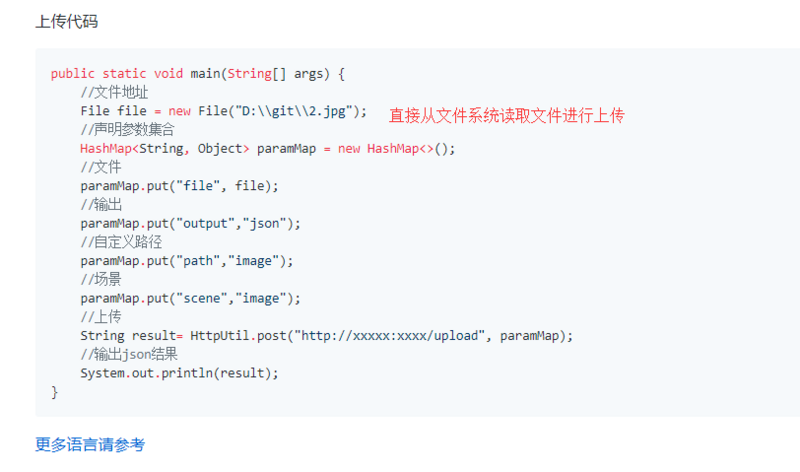在SpringMVC/SpringBoot控制器中通过获取文件输入流方式上传文件到go-fastdfs的几种实现
这是转载的文章,之所以转载,是因为原作者漏了一个hutool的import,导致我浪费了5个小时,而原作者的文章不能评论,特此转载+说明。
就是这行代码坑了我5个小时:
import cn.hutool.core.io.resource.InputStreamResource;
最近很多朋友在go-fastdfs的微信群里面问道,go-fastdfs什么时候支持流上传?其实一直都支持的!为什么这样子说呢?因为go-fastdfs本身就是基于http协议进行传输的,那么如果有读者对Java的HttpURLConnection的源码研究过的话,会发现其内部也是可以通过conn.getInputStream()和conn.getOutputStream()获取其输入输出流,通常可以直接往outputStream里面写入符合http协议的数据。那么根据这个特点,在Java里面,直接通过流的形式(通常是从MultipartFile里面获取InputStream)再上传到go-fastdfs是没问题的。跟http协议相关的知识点包括http协议报文格式和上传二进制数据等如果不了解可以先自行百度一下。这里不会细讲的哦。
引发认为go-fastdfs不能直接流上传的原因
经过本人的分析认为,让广大读者认为不能直接使用流上传的原因应该是go-fastdfs的github的代码示例造成一些误会。不过官方的代码示例并没有错误,只是直接从本地读取文件系统的文件,形成File对象进行上传。针对使用Spring等框架接收前端上传过来的文件再进行转发上传到go-fastdfs的用户,就可能会有疑惑。因为获取到的是MultipartFile,而非java.io.File。

Hutool-http、HttpClient、OkHttp3多种方式流式文件上传
由于有不少人问到上面的问题,现在本人总结了一个常用的几种http客户端文件流式上传的方式,相当于给自己做下记录,同时也给有这方面疑问的朋友一个借鉴。废话不多说,直接上代码吧。代码是基于springboot的maven工程。
Hutool-http方式
先在pom中添加hutool的依赖
<dependency>
<groupId>cn.hutool</groupId> <artifactId>hutool-all</artifactId> <version>4.5.1</version>
</dependency>
接着在Controller中代码示例
import cn.hutool.core.io.resource.InputStreamResource;
@RequestMapping("/upload")
public String upload(MultipartFile file) {
String result = "";
try {
InputStreamResource isr = new InputStreamResource(file.getInputStream(),
file.getOriginalFilename());
Map<String, Object> params = new HashMap<>();
params.put("file", isr);
params.put("path", "86501729");
params.put("output", "json");
String resp = HttpUtil.post(UPLOAD_PATH, params);
Console.log("resp: {}", resp);
result = resp;
} catch (IOException e) {
e.printStackTrace();
}
return result;
}
HttpClient方式
pom依赖
<dependency>
<groupId>org.apache.httpcomponents</groupId> <artifactId>httpclient</artifactId>
</dependency>
<dependency>
<groupId>org.apache.httpcomponents</groupId> <artifactId>httpmime</artifactId>
</dependency>
接着在Controller中代码示例
@RequestMapping("/upload1")
public String upload1(MultipartFile file) {
String result = "";
try {
CloseableHttpClient httpClient = HttpClientBuilder.create().build();
CloseableHttpResponse httpResponse = null;
RequestConfig requestConfig = RequestConfig.custom()
.setConnectTimeout(200000)
.setSocketTimeout(2000000)
.build();
HttpPost httpPost = new HttpPost(UPLOAD_PATH);
httpPost.setConfig(requestConfig);
MultipartEntityBuilder multipartEntityBuilder = MultipartEntityBuilder.create()
.setMode(HttpMultipartMode.BROWSER_COMPATIBLE)
.setCharset(Charset.forName("UTF-8"))
.addTextBody("output", "json")
.addBinaryBody("file", file.getInputStream(),
ContentType.DEFAULT_BINARY, file.getOriginalFilename());
httpPost.setEntity(multipartEntityBuilder.build());
httpResponse = httpClient.execute(httpPost);
if (httpResponse.getStatusLine().getStatusCode() == 200) {
String respStr = EntityUtils.toString(httpResponse.getEntity());
System.out.println(respStr);
result = respStr;
}
httpClient.close();
httpResponse.close();
} catch (Exception e) {
e.printStackTrace();
}
return result;
}
OkHttp3上传示例
pom文件依赖
<dependency>
<groupId>com.squareup.okhttp3</groupId> <artifactId>okhttp</artifactId> <version>3.9.1</version>
</dependency>
接着在Controller中代码示例
@RequestMapping("/upload2")
public String upload2(MultipartFile file) {
String result = "";
try {
OkHttpClient httpClient = new OkHttpClient();
MultipartBody multipartBody = new MultipartBody.Builder().
setType(MultipartBody.FORM)
.addFormDataPart("file", file.getOriginalFilename(),
RequestBody.create(MediaType.parse("multipart/form-data;charset=utf-8"),
file.getBytes()))
.addFormDataPart("output", "json")
.build();
Request request = new Request.Builder()
.url(UPLOAD_PATH)
.post(multipartBody)
.build();
Response response = httpClient.newCall(request).execute();
if (response.isSuccessful()) {
ResponseBody body = response.body();
if (body != null) {
result = body.string();
System.out.println(result);
}
}
} catch (Exception e) {
e.printStackTrace();
}
return result;
}
总结
上面给出了几个示例,是不是都挺简单的?通过这种方式,就可以在Controller中做中转了,还是挺方便的。顺便提一下,上面几种方式中,我个人觉得Hutool的是最简单的,最方便的,对于HttpClient而言,概念比较多,显得相对复杂,OkHttp也一样,不过比HttpClient显得优雅点。针对一般的并发量,个人觉得hutool的Http已经够用了,底层是基于jdk的HttpUrlConnection实现的。如果对性能有特殊要求的,可以考虑httpclient或者OKHttp,后两者相对而言,更推荐使用OkHttp。
- 本文标签: HTTP协议 maven UI 总结 ACE java springboot git App client IO db map 文件上传 http spring id ip 代码 build ORM 源码 并发 cat SpringMVC core 文件系统 GitHub Connection 2015 协议 stream js json entity FastDFS pom 数据 百度 文章 apache HashMap https parse src
- 版权声明: 本文为互联网转载文章,出处已在文章中说明(部分除外)。如果侵权,请联系本站长删除,谢谢。
- 本文海报: 生成海报一 生成海报二










![[HBLOG]公众号](https://www.liuhaihua.cn/img/qrcode_gzh.jpg)

